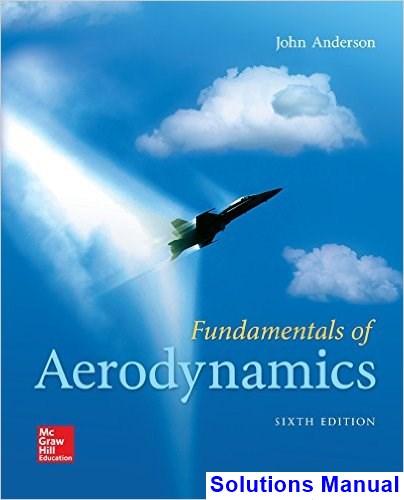
However, the integral of the surface vector over a closed surface is zero, i.e.,
Hence, combining

Denote the pressure distributions on the upper and lower walls by pu(x) and p e (x) respectively.
The walls are close enough to the model such that Pu and p 1 are not necessarily equal to Poo· Assume that faces ai and bh are far enough upstream and downstream of the model such that and v = 0 and ai and bh.
Take they-component ofEq. (2.66)
L = - # (p v.dS) v - H(p dS)y
S abhi
The first integral= 0 over all surfaces, either because V · ds = 0 or because v = 0. Hence
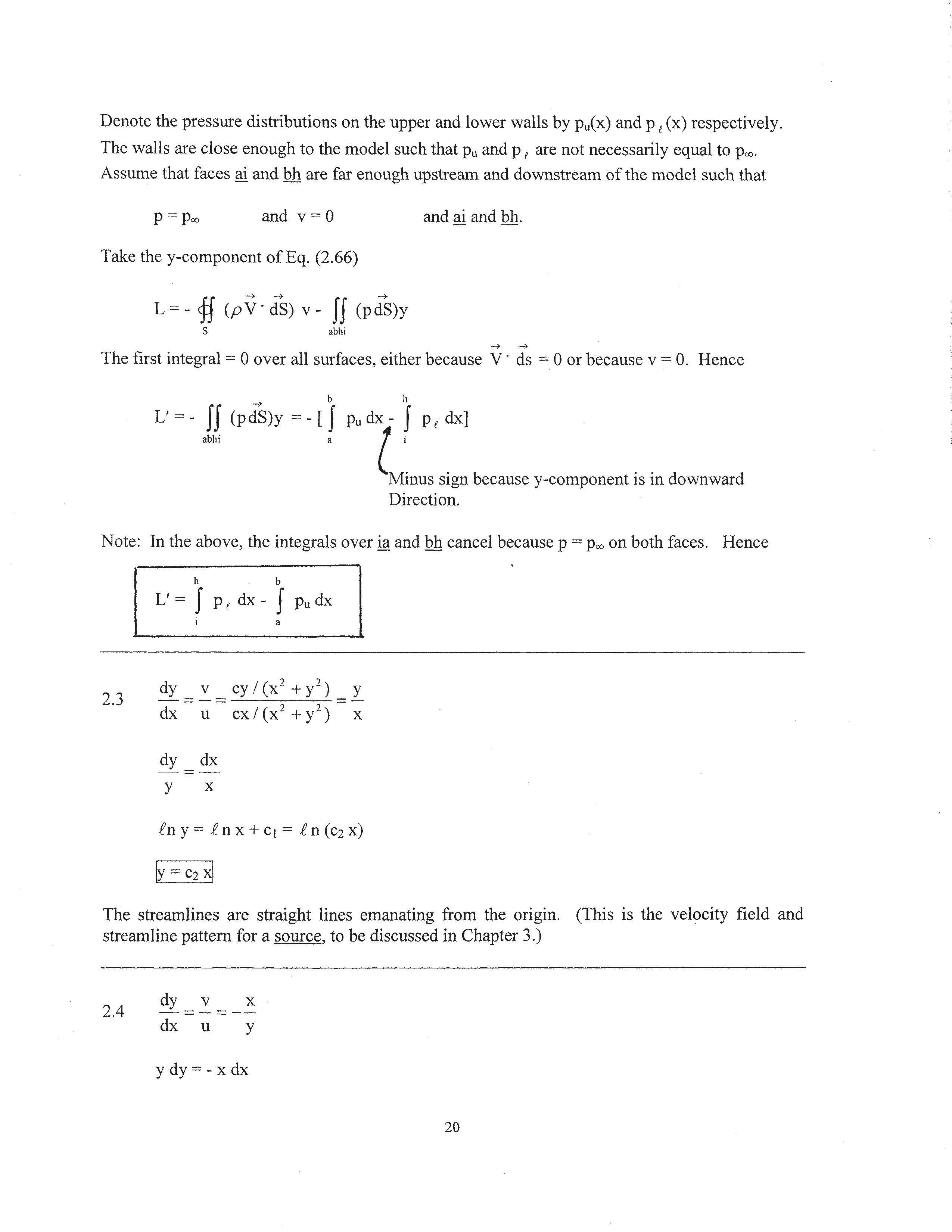
-> b h
L' = - fJ (pdS)y = -[ J Pu dx - J p 1 dx] •bM •
Minus sign because y-component is in downward Direction.
Note: In the above, the integrals over ia and bh cancel because p = Poo on both faces. Hence h b L' = J pf dx - J Pu dx
The streamlines are straight lines emanating from the origin. (This is the velocity field and streamline pattern for a source, to be discussed in Chapter 3.)
y 2 = -x 2 + const
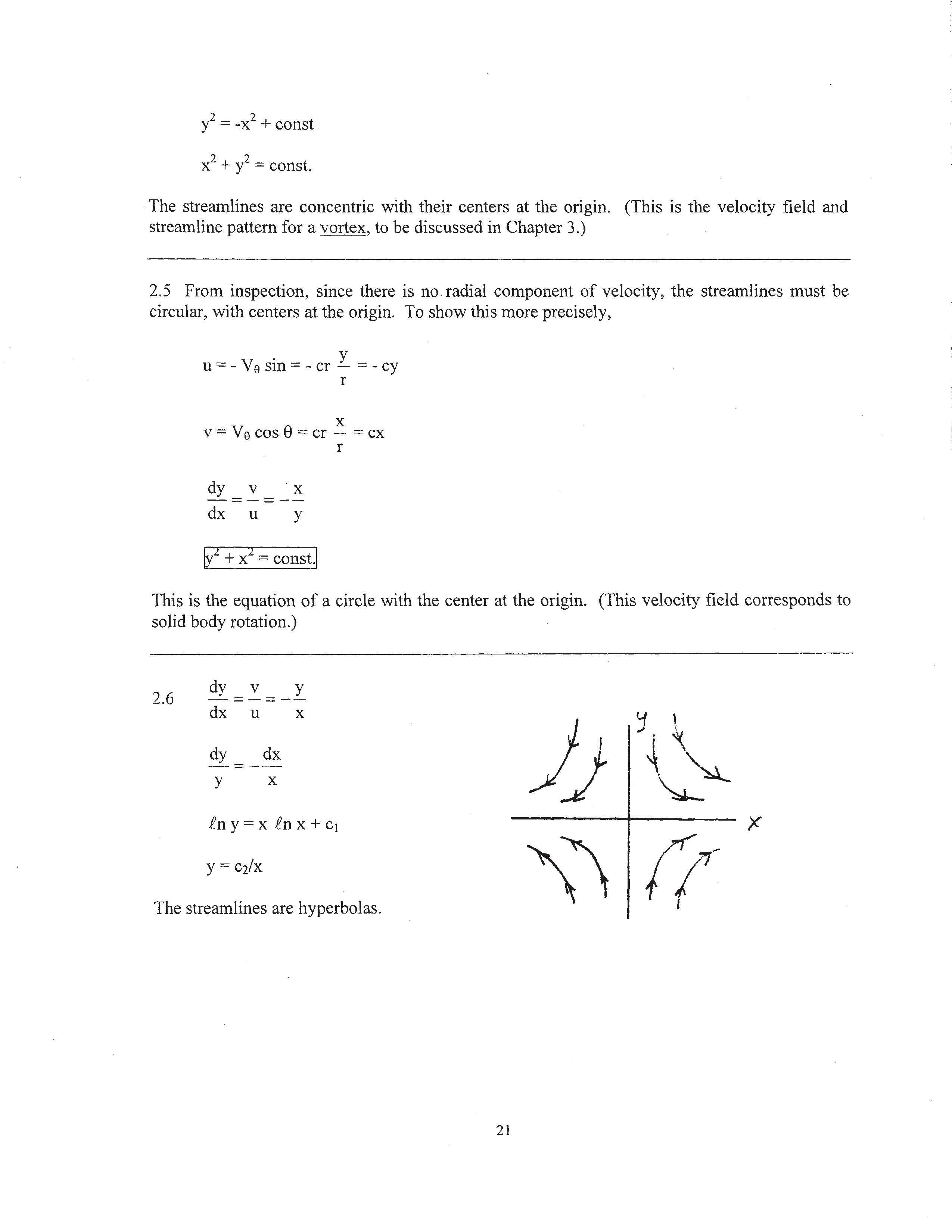
x 2 + y2 = const.
The streamlines are concentric with their centers at the origin. (This is the velocity field and streamline pattern for a vortex, to be discussed in Chapter 3.)
2.5 From inspection, since there is no radial component of velocity, the streamlines must be circular, with centers at the origin. To show this more precisely,
u = - v e sin = - er r = - cy r x
v = Ve cos 8 = er - = ex r
dy v x = = dx u y
& 2 + x 2 = const.J
This is the equation of a circle with the center at the origin. (This velocity field corresponds to solid body rotation.)
2.6 dy v y = = dx u x
dy dx = y x
fn y = X £n X + C1 x
y = C2/x
The streamlines are hyperbolas. f
Copyright © 2017 McGraw-Hill Education. All rights reserved. No reproduction or distribution without the prior written consent of McGraw-Hill Education
__, 1 o
In polar coordinates: V · V = -- (r Vr) + --r cr roe
y
Vr
ve = - u sin e + v cos 8
22
reproduction or distribution without the prior written

ex er cosB
u= (x2 + y2) ? c
cy er sine
v= = (x2 + y2) r1
c 2 c . 2 c v r = - cos e + - sm e =r r r
c cosB r c sine r
Ve= - cose sine+ cose sine= 0 r r -> 1 8 1 8(0)
V V = -- (c) + = 0 r a: r !JB
(b) From Eq. (2.23)
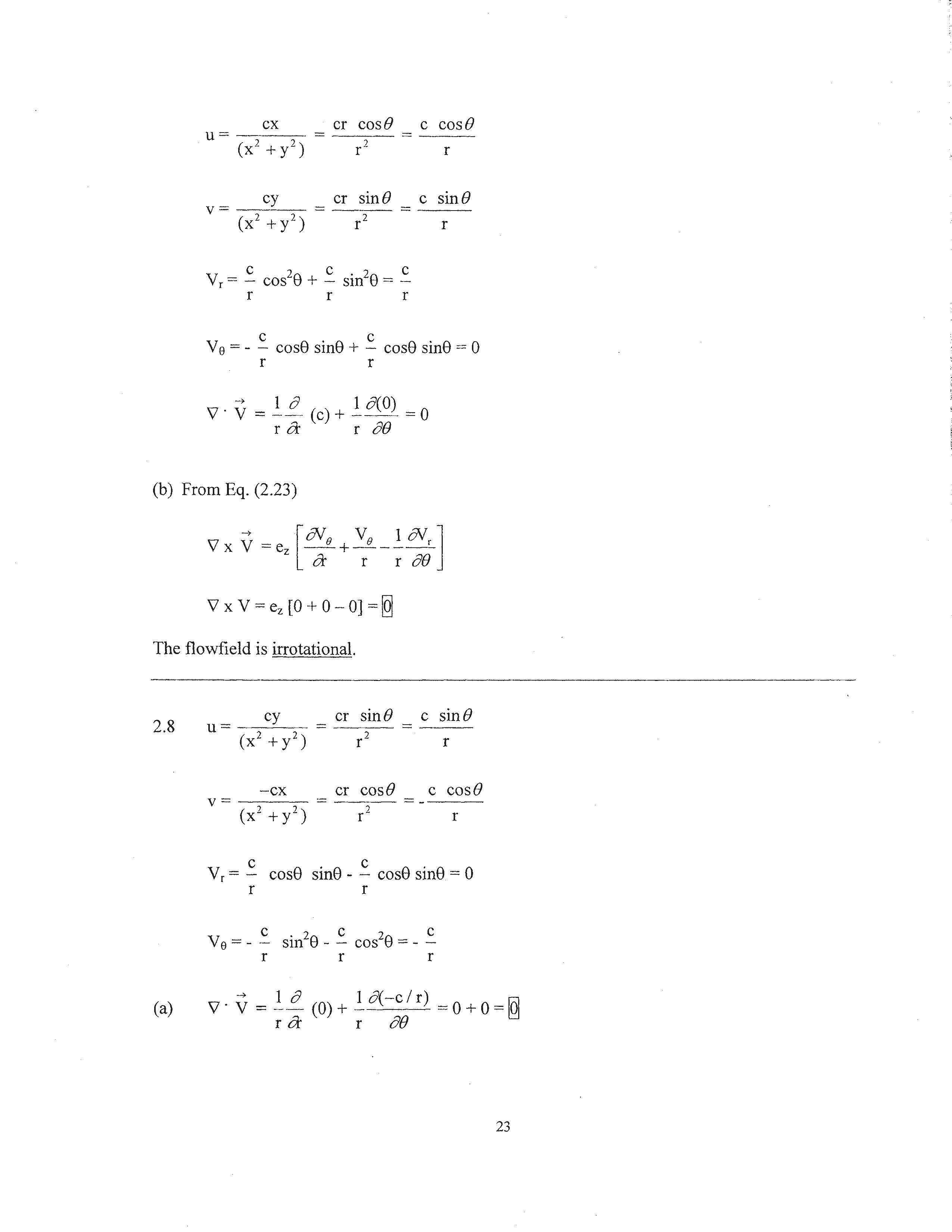
V x V = ez [O + 0 - O] =
The flowfield is irrotational.
2.8 cy er sine c sine
u= = = (x2 +y2) ? c r
-ex er cose c cose
v= = -(x2+y2) ? c r
Yr= cose sine - cose sine= 0 r r
c ·2 c 2 c v e = - - sm e - - cos e = -r r r
(a) v· v= (O)+ 18(-c/r) r a: r 8()
Copyright © 2017 McGraw-Hill Education. All rights reserved. No reproduction or distribution without the prior written consent of McGraw-Hill Education
(b) V'x V= e--+ [O'(-c/r) z a r 2 r oe
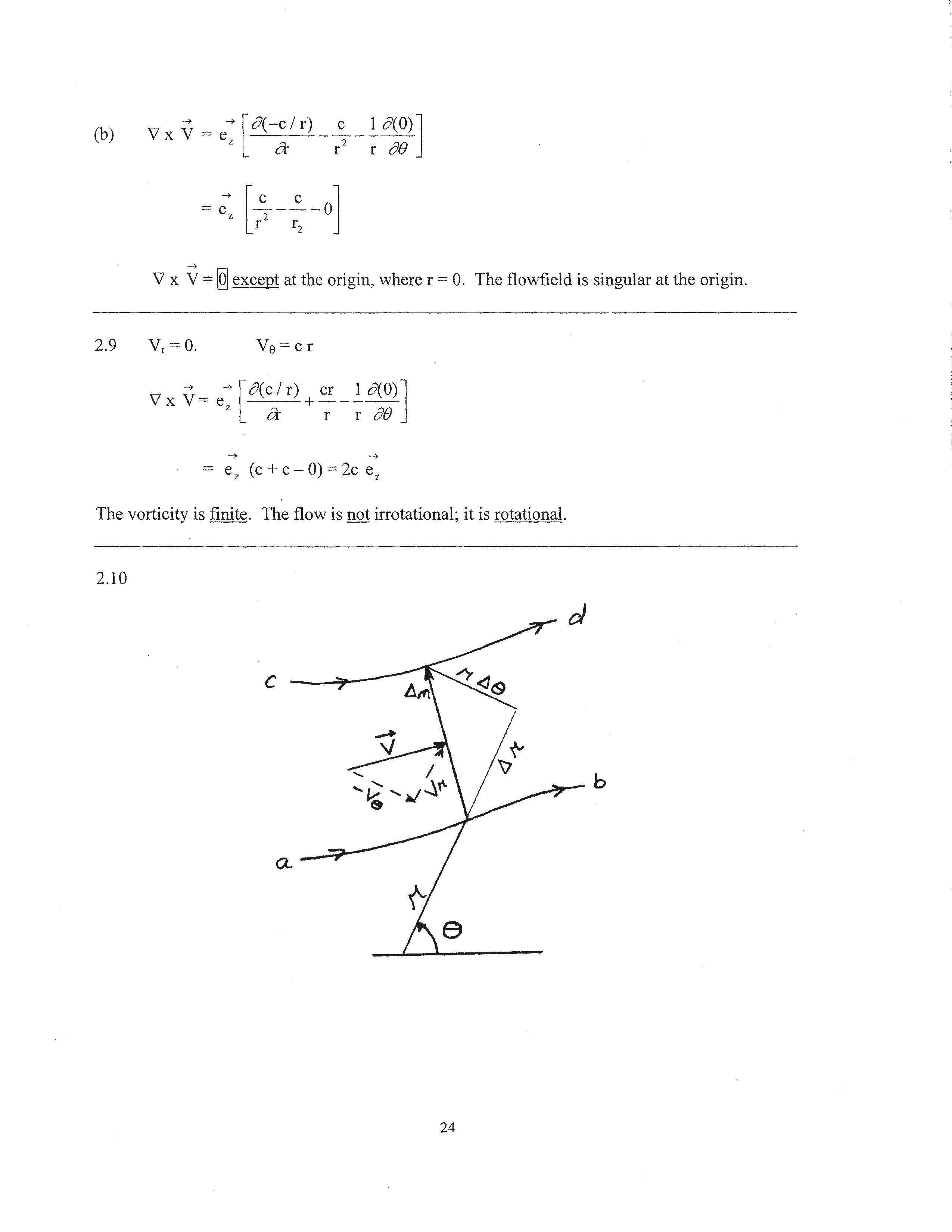
V' x V at the origin, where r = 0. The flowfield is singular at the origin.
2.9 Ve=cr
V'x V= e__,, [o(c/r) +er_..!_ o(O)J z a r roe
--7 --7
ez (c + c - 0) = 2c ez
The vorticity is finite. The flow is not irrotational; it is rotational.
Copyright © 2017 McGraw-Hill Education. All rights reserved. No reproduction or distribution without the prior written consent of McGraw-Hill Education
Mass flow between streamlines = Ll f;t
Lllf/ =pV Lln
Ll f;t = (-p Ve) M + p Yr (r8)
Let cd approach ab
Also, since f;t = f;t (r,9), from calculus - 3,;,. 3,;,. d If/ = _'f' dr + _'f' de a 8e
8f;t -pVe=a
Comparing Eqs. (1) and (2) and
P rV = 3 f;t r 8B 8f;t pVe=-a 2.11 u = ex = 8 1// : ljf = cxy + f(x) 07

or:
Copyright © 2017 McGraw-Hill Education. All rights reserved. No reproduction or distribution without the prior written consent of McGraw-Hill Education
Comparing Eqs. (1) and (2), f(x) and f(y) =constant
l\jf = c x y + const. I
u = ex = Olf/ : = cx 2 + f(y) &
v = - cy = Olf/ : = - cy 2 + f(x) 0'
Comparing Eqs. (4) and (5), f(y) = - cy 2 and f(x) = cx 2
0 =ex dy + cy dx
Differentiating Eq. (3) with respect to x, holding \jf = const. or,
( -dy) =-y/x dx \lf=const
Differentiating Eq. (6) with respect to x, const. or,

dy 0=2cx-2cydx
( dy) = x/y dx ¢=const
Comparing Eqs. (7) and (8), we see that
Hence, lines of constant \jf are perpendicular to lines of 26
Copyright © 2017 McGraw-Hill Education. All rights reserved. No reproduction or distribution without the prior written consent of McGraw-Hill Education
2.12. The geometry of the pipe is shown below.
t{ =/CJC> ..-w /:s-ec.,..(I
As the flow goes through the U-shape bend and is turned, it exerts a net force Ron the internal surface of the pipe. From the symmetric geometry, R is in the horizontal direction, as shown, acting to the right. The equal and opposite force, -R, exerted by the pipe on the flow is the mechanism that reverses the flow velocity. The cross-sectional area of the pipe inlet is nd2/4 where dis the inside pipe diameter. Hence, A= nd2/4 = n(0.5)214 = 0.196m2 The mass flow entering the pipe is
• m = P1 A V1=(1.23)(0.196)(100)=24.11 kg/sec.
Applying the momentum equation, Eq. (2.64) to this geometry, we obtain a result similar to Eq. (2.75), namely

R = - # (p V · dS) V (1)
Where the pressure term in Eq. (2.75) is zero because the pressure at the inlet and exit are the same values. In Eq. (1), the product (p V · dS) is negative at the inlet (V and dS are in opposite directions), and is positive at the exit (V and dS) are in the same direction). The magnitude of p
• V · dS is simply the mass flow, m. Finally, at the inlet V1 is to the right, hence it is in the positive x-direction. At the exit, V2 is to the left, hence it is in the negative x-direction. Thus, V2 = - V1. With this, Eq. (1) is written as
R = - [- m V 1 + m V2] = m (V 1 - V2)
• • = m [V1 -(-V1)] = m (2V1)
R = (24.11)(2)(100) = &822 NI
Integrating
Integrating
Comparing (2.35b) and (2.36b), which represent the same function for , we see in (2.36b) that f(x) = V∞ x. So the velocity potential for the compressible subsonic flow over a wavy well is:
2.14 The equation of a streamline can be found from Eq. (2.118)

For the flow over the wavy wall in Example 2.1,
then → 0. Thus,
The slope is zero. Hence, the streamline at y → ∞ is straight.
Copyright © 2017 McGraw-Hill Education. All
